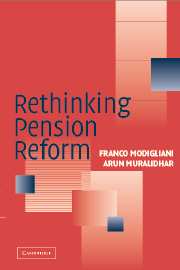Book contents
- Frontmatter
- Contents
- Preface
- Acknowledgments
- A Tribute to Franco
- Rethinking Pension Reform
- 1 A Primer on Pension Reform
- 2 A Taxonomy of Pension Reform Issues
- 3 An Evaluation of Pension Reforms
- 4 Welfare Costs of Defined Contribution Schemes
- 5 The Transition from PAYGO to Funding with a Common Portfolio: Application to the United States
- 6 Social Security Reform in Spain
- 7 The “Two-Pension Fund” Theorem
- 8 The Case for Mixed Systems and Variable Contributions: Improving the Performance of Pension Systems
- References
- Index
2 - A Taxonomy of Pension Reform Issues
Published online by Cambridge University Press: 22 August 2009
- Frontmatter
- Contents
- Preface
- Acknowledgments
- A Tribute to Franco
- Rethinking Pension Reform
- 1 A Primer on Pension Reform
- 2 A Taxonomy of Pension Reform Issues
- 3 An Evaluation of Pension Reforms
- 4 Welfare Costs of Defined Contribution Schemes
- 5 The Transition from PAYGO to Funding with a Common Portfolio: Application to the United States
- 6 Social Security Reform in Spain
- 7 The “Two-Pension Fund” Theorem
- 8 The Case for Mixed Systems and Variable Contributions: Improving the Performance of Pension Systems
- References
- Index
Summary
INTRODUCTION
The existing confusion over privatization, and what it implies, makes it important to clarify the meaning of social security and the “desirable properties” it should strive to achieve. This chapter establishes the basic principles by which a social security system may be evaluated. It reviews some basic pension concepts and highlights the desirable characteristics of any social security system by explicitly stating the trade-offs in the selection of different social security design aspects. It creates a yardstick by which any social security system can be measured and provides a simple format that will help decision makers analyze the merits and demerits of any proposal. Finally, for a given set of desirable macro- and microeconomic properties, this chapter offers an “Ideal Model” and compares it with other models implemented around the world. A transition from the current systems in the United States and Spain to an implementable version of the “ideal” system is explored in Chapters 5 and 6, respectively. This chapter concludes with suggestions for simple modifications to improve the design of currently implemented reforms.
SOCIAL SECURITY: DEFINITION, DESIRABLE PROPERTIES, AND DESIGN FEATURES
SOCIAL SECURITY
The proposition that social security must be provided by the government is a fundamental aspect of old age support that has begun to get clouded in reform discussions. In essence, unless one takes a libertarian view, it is the role of the government to ensure that people do not reach old age poor (Aaron and Reischauer 1998, and Diamond 1995).
- Type
- Chapter
- Information
- Rethinking Pension Reform , pp. 17 - 41Publisher: Cambridge University PressPrint publication year: 2004



